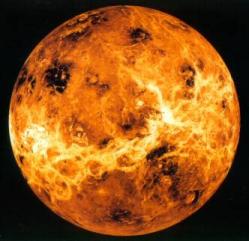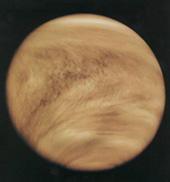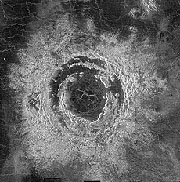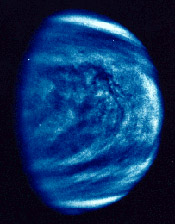
![]() Main Page
Main Page
![]() Feedback
Feedback
 The Author
The Author
 News
News
 Search
Search
 The Planets
The Planets
 Mercury
Mercury
 Venus
Venus
 Earth
Earth
 Mars
Mars
 Jupiter
Jupiter
 Saturn
Saturn
 Uranus
Uranus
 Neptune
Neptune
 Pluto
Pluto
 Dwarf Planets
Dwarf Planets
 The Solar System
The Solar System
 The Sun
The Sun
 The Moon
The Moon
 Meteors
Meteors
 Comets
Comets
 Asteroids
Asteroids
 Amazing facts
Amazing facts
 Other
Resources
Other
Resources
 Poster Store
Poster Store
 Multimedia
Multimedia
 Links
Links
 Awards
Awards
 Glossary
Glossary
 Astronomers
Astronomers
 Webrings
Webrings
 Bibliography
Bibliography

Technical Data:-
Diameter |
12,104 km |
Average Distance from Sun |
108.2 million km |
Mass |
4.87 x 1024 kg |
Size compared to Earth |
0.95x |
Gravity compared to Earth |
0.88x |
Surface Temperature |
484oC (730K) |
Length of day |
243 Earth days (retrograde) |
Length of year |
224.7 days |
Eccentricity of Orbit |
0.00677 |
Density |
5.25g/cm3 |
Atmosphere |
Carbon Dioxide - 96% |
More pictures of Venus Here |
Print this information out Here |
|||||||||||||
| ||||||||||||||
Venus (named after the Goddess of Love) is the planet second closest to the Sun, and the hottest planet in the Solar System. From looking at most of the facts, Venus initially appears to be very similar to Earth. The reality is, however, very different. OK, so it might be just 652 km thinner, have similar composition, mass and position, but for a start, Venus' surface temperature is a scorching 484°C, secondly it is thought to be completely lifeless, and thirdly its surface pressure is akin to that of an ocean bed (92 times that of Earth at sea level) - a pressure high enough to pulverise and crush Venus' surface rocks. Venus: Scorching Inferno
All of these major features stem from one key difference to the Earth - Venus has no water. This explain Venus' very dense (mainly Carbon Dioxide) atmosphere - here on Earth the water of the oceans removes CO2 from our atmosphere and keeps our planet in a state such that we can live on it (in fact the same quantity of Carbon Dioxide has come out of the Earth's interior as is in Venus' atmosphere!). In Venus however there is no water to absorb the CO2 and so the atmosphere thickens and produces a runaway greenhouse effect, so the rays (and heat) of the Sun shine onto the planet and are then trapped there by the dense atmosphere. In fact, it is very likely that at one point Venus did have water on it, but because Venus is about 50 million km closer to the Sun than the Earth is (two thirds of the way between the Sun and Earth) any remnants of this water have long since evaporated. Venus' thick atmosphere makes it very hard for us to see the actual surface of the planet. The first ideas of what the planet may look like came in the 1960s when we were able to see through the clouds, albeit in quite a primitive fashion, with radar imaging from ground-based telescopes. However, global scale radar mapping of Venus' surface did not start until the Pioneer space probe arrived at Venus in 1978-80, and mapped many of its basic surface features. These were followed by the Soviet Veneras 15 and 16 but it wasn't really until the Magellan Orbiter arrived in 1992 that we really got a good idea of what Venus was like.
When the data from the Magellan mission did come through though, it surprised many scientists, as there were only a tenth the amount of craters that would be expected had Venus been as old as we thought it was, and the ones which were there were all found to be relatively fresh. There are now two theories for this - one is that volcanic eruptions destroy craters as fast as they are made so there will always be a constant number of craters on Venus, and the other is that 500 million years or so ago, volcanic eruptions resurfaced the planet, destroying all previous craters. Another thing these space probes found was that at least 85% of Venus is covered by volcanic rock! These are mostly from lava flows and form the planet's vast plains. Venus interestingly spins in the opposite direction to the Earth and to most of the other planets in the Solar System (so the Sun rises in the West instead of the East from Venus' surface), and rotates very slowly, with a Venusian day (243 Earth days) being longer than a Venusian year (225 Earth days) - So every other day on Venus is New Year's eve! So why should Venus's rotational pattern have this particular characteristic? Well, astronomers simply do not know for sure. The two main theories are that either a huge chunk of debris crashed into the planet a long time ago, and sent it spinning in the opposite direction, or simply that most of the boulders that clumped together to form Venus were originally spinning in an opposite direction to those that formed the rest of the Solar System.
As mentioned above, Venus does not have any water on its surface. However, it does have some water vapour in the atmosphere, which form rain clouds. Unlike rainclouds we're used to seeing however, these are rather deadly Sulphuric Acid clouds which produce very corrosive Sulphuric Acid rain. However, any future Venusian astronauts shouldn't get too concerned about this, for the surface of Venus is so hot that the rain evaporates before it even touches the ground! Looking at its statistics, one would expect a planet such as Venus, with a very slow spin, to have very calm weather, with very little atmospheric turbulence. Again however, observations have proved intuition wrong, and have shown that clouds around the equator, about 50-60km above the surface, can move at speeds of up to 350km/hour, a fact which is surprising considering the planet itself spins 50 times slower. Even closer to Venus' surface, where scientists would expect the very dense atmosphere to create calmer conditions, there is evidence, from data supplied by the Galileo spacecraft, that there are great storm clouds at altitudes of only 30km. Until further data is obtained, scientists can only guess at the reason for this peculiar mystery. And yet, despite all this evidence that Venus is such a hostile, lifeless world, there are some who claim that it is very possible that there are living microbes present in Venus' clouds. Indeed, recent evidence has confirmed that a long time ago, Venus was in fact a warm planet, with water flowing on its surface, not altogether too dissimilar from Earth in fact. Some scientists therefore argue that life could have easily begun in these surroundings and, provided Venus heated up gradually, some forms of life could have adapted to survive in these conditions, and may still be living in the acidic clouds 50-70km above the surface of the planet. The pressure and heat levels would be more bearable than on the surface, with temperatures of around 50-70°C. There would also be some form of water present in these clouds, though probably tied up with hydrated sulphur compounds. Whilst this may be considered a slightly far fetched theory, it does nonetheless have an intriguing element about it. However one must bear in mind that any life present on Venus today could still be no more sophisticated than simple microbes. Observing Venus The planet itself is visible in the night sky a few hours before sunrise (as the Morning Star) & after sunset (as the Evening Star) at certain times of the year and it looks like a brilliant blue-white star. Venus can rarely also be seen passing between the Earth and the Sun, and on such occasions appears as a black dot travelling across the Sun. Don't hold your breath if you're waiting to see one of these transits of Venus though - the next one will be in 2012 and the one after that will be in 2117. |
||||||||||||||
Brief History:- |
||||||||||||||
In 1962 the Mariner 2 space probe flew by Venus and was followed in 1970 by the Russian Venera 7 which landed on Venus but lasted just 23 minutes before being burnt like toast and disintegrating. In 1972 Venera 8 also landed on Venus followed in 1975 by Venera 9. Then an American probe, the Pioneer Venus Orbiter mapped Venus and the Pioneer Venus Multiprobe dropped four probes on Venus. Following that, Veneras 15 and 16 mapped Venus followed by the also Russian Vegas 1 & 2 in 1984 which also dropped landers. Four years later, in 1990, Magellan arrived at Venus, mapping it in great detail to reveal craters and Volcanoes we never knew existed. More recently, Venus has been studied by the uropean Space Agency's Venus Express spacecraft. |
||||||||||||||
Venus Links |
||||||||||||||
|
||||||||||||||

Maat Mons Volcano on of Venus, taken from Magellan Spacecraft
Buy poster at Allposters.com



